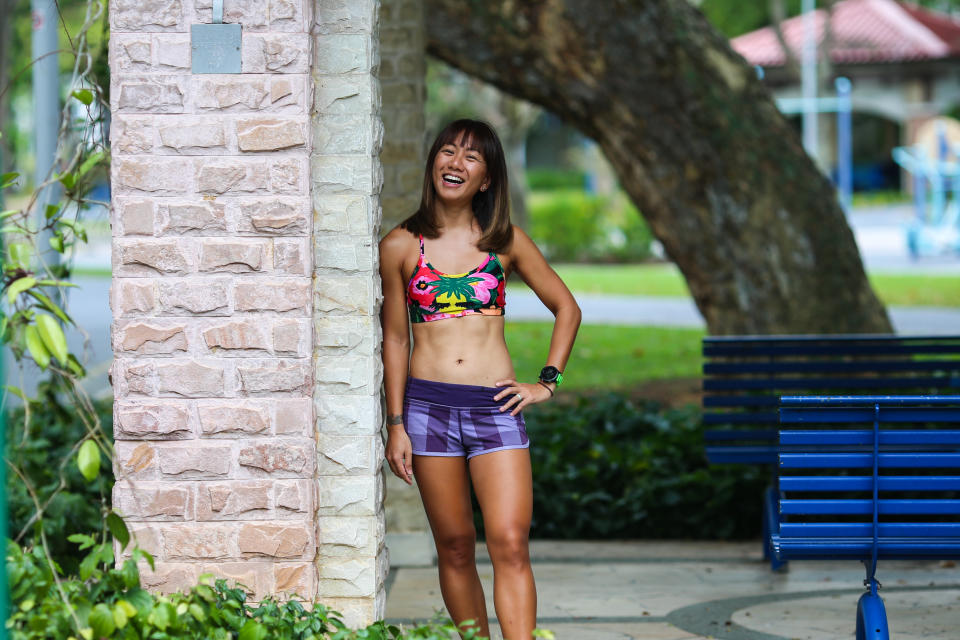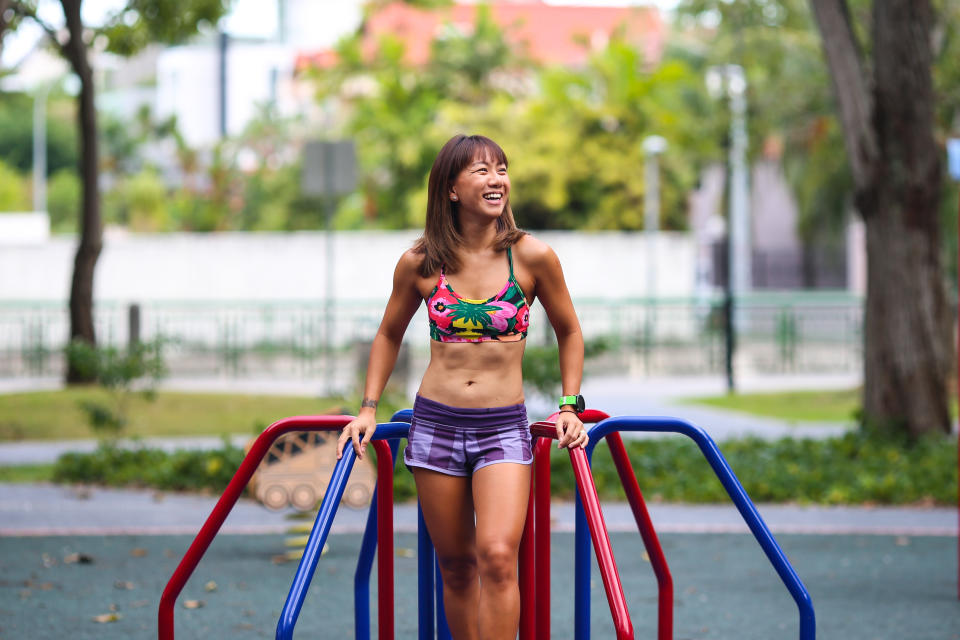Singapore #Fitspo of the Week: Tammi Lim

Life goes beyond the digits on the scale and your body is capable of so much more. Yahoo’s #Fitspo of the Week series is dedicated to inspirational men and women in Singapore leading healthy and active lifestyles. Have someone to recommend? Hit Cheryl up on Instagram or Facebook.
Name: Tammi Lim (@tim.tamss)
Age: 33
Height: 1.57m
Weight: 48kg
Occupation: Personal Trainer
Status: Married
Diet: I strongly believe in having a well-balanced diet with a good mix of carbohydrates, protein and fat. As I am physically active every day, sometimes with two sessions a day, I make sure the majority of my nutrient source comes from carbohydrates which i mostly get from whole grains such as oats, brown rice, wholemeal bread and brown rice bee hoon, loads of vegetables and fruits. My protein sources usually come from lean meat like chicken and fish, eggs, dairy, nuts and soy, and my fat sources from peanut butter, nuts, avocados and vegetable oils. I have three main meals a day with
a light snack such as fruits or nuts in between. As much as I try to eat healthy, I do have a weak spot for french fries, ice cream and chocolate which I do indulge in occasionally.
Training: Each week I run 3-4 times, cycle 2-3 times, swim 1-2 times, strength train 1-2 times and play tennis 1-2 times. On average I spend around 14-15 hours a week on physical activity. A typical run and cycle session usually consists of thresholds, intervals, steady state and recovery while my swim sessions are nothing spectacular – plain, old, boring 30 laps, unless I have an event to train for. For strength, I focus mainly on functional movements, incorporating many muscle groups (mostly major ones). And I love a strong core so I spend quite some time on it as well.
Q: Were you an active kid?
A: No! I was so unfit as a kid, often failing my NAPFA test runs and I hated physical activity. I did join some swimming and badminton lessons when I was in primary school, but unfortunately they didn’t last very long. It was good enough for me to know how to swim and not drown and to play a proper badminton game though, but nothing competitive.
When did you start to enjoy fitness then?
I picked up leisure swimming again when I was 18. While I was furthering my studies overseas, I discovered the joy of running and started taking part in running events all around, flying to different states and driving to different cities. I was neither fast nor competitive; I just enjoyed being active and fit. It was also then that I picked up recreational tennis.
My triathlon journey started in 2011 when I bought my first road bicycle, and I have not looked back ever since. I am such a late developer, but I always believe it is better late than never, and I am a walking example to my clients that nothing is impossible. I was once that unfit and scrawny little girl that hated sports and couldn’t run for nuts.

How did you get into personal training?
I left my full-time corporate job to pursue a new career in fitness by joining a commercial gym as a full-time fitness instructor. There, they provided lots of theory and practical training, certifications and on-the-job training.
Slowly I learned the ropes of the trade, gained as much experience as I could and left about a year later to venture out as a freelancer.
What made you decide to leave your corporate job?
In 2012, I decided to leave the corporate world as it didn’t give me the job satisfaction I was looking for. It was a very routine 9-to-6 job which I clearly wasn’t enjoying. I was also just starting out with triathlon at that time, and I was very excited about this whole new sport and lifestyle, so much so that I wanted to embark on a career in the the fitness industry.
I wanted to learn more about sports and exercise science in order to understand the biomechanics of sports, principles of training etc, to help develop myself as a novice triathlete. Then I started to find joy and satisfaction when people that I have been training starting showing positive changes. That’s when I knew that I really like this new job.
What are some of the challenges being a personal trainer?
The biggest challenge was starting out and building a decent client base. Honestly, it was difficult at the start and it didn’t help when this industry is highly competitive and with me being a terrible sales and marketing person.
Luckily for me, a couple of clients I was training before at the gym stuck with me when I left. From there my client base started to grow through referrals from clients/friends/family. But because clients come and go, maintaining that base is always a challenge no matter what.

Client commitment is also another big challenge. Because majority of my clients are either sedentary or lightly active, they are often lacking in discipline to commit to the prescribed exercise programme and nutrition. I constantly need to find ways to motivate them and push them out of their comfort zone, otherwise there is no way they will see results.
A lot of people have the misconception that hiring a personal trainer will do wonders, but they fail to realise that personal training requires dedication and effort from both the trainer and the client. Also, I’ve faced clients with injuries such as scoliosis, back pain, knee pain and even pregnant women. As a
trainer you’ll need to be aware of the dos and don’ts when developing an exercise programme for this population, not to mention a lot of research and upgrading of knowledge is required.
What are your fitness goals now?
I am taking a break from triathlon for a while, so for now I am just looking into maintaining my fitness levels and making sure I don’t lose what I have gained throughout the years. Oh, and keeping my weight in check!
When did you feel the least confident about yourself?
Not being fast and good enough in the multi-sport scene is something I have been dealing with. I tend to compare myself with faster individuals and it makes me feel incompetent and lousy.
How did you overcome it?
I wouldn’t say I have overcome it, but I constantly try to remind myself that I have progressed from being skinny, unfit and barely being able to pass my NAPFA test to finishing an Ironman event, and that itself is an affirmation of how far I’ve come.

Are you satisfied with your body now?
Yes and no. I like that I am much stronger and fitter now but at the same time I am still working on getting leaner.
Do you get any comments about your body?
Positive comments, fortunately. It’s funny how the biggest critic is yourself – what you see on yourself as a flaw is seen as something positive to others.
What are some misconceptions of fitness in today’s society?
I am always being asked, “Will my muscles turn into fat once I stop lifting weights” The answer is no, it is impossible for muscles to turn into fats. If you stop lifting weights, you will lose muscle mass, and when you lose muscle mass, your metabolic rate drops.
Once your metabolic rate is lower, your body burns energy at a slower rate and if you do not reduce the amount of calories you consume, there is a higher chance that the excess energy from food will be stored as fat, leading to weight gain, thus creating the impression that your “muscles have turned to fat”.




